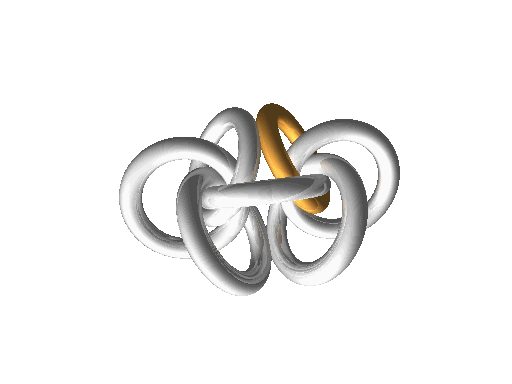Submitted ByEdit Dates
Date Uploaded: February 9, 2004, 10:33 pm Last Edited: December 12, 2012, 12:38 pm |
 Add to Add toSite Favourites Print this Article |
Hoodoo Sheet
(CGI)
Article © MAIL User: Blaise
In its sheet form, Hoodoo requires a minimum aspect ratio of approximately 4. The chain version of Hoodoo is a single row of Hoodoo units, with the outer rings stripped off, and can be constructed using aspect ratios down to 3.
Step 1:
Start with a single ring. Keep it in mind that every ring in this weave has a "lean" to it, and if a ring leans the wrong way, the weave will have a flaw.

Step 2:
Attach another ring to the first Make sure it is held such that it has the same lean as the first. Note that in the example, the lean of this cluster of rings is clockwise.

Step 3:
Add a third ring to the first two, passing it entirely through the internal plane of both rings.

Step 4:
Complete the cluster with a fourth ring, being careful to maintain the clockwise lean. This cluster of rings demonstrates the method by which every ring in the weave will be joined to others.


Step 5:
Now begin another cluster which uses one of the rings from the first cluster. Start by linking a ring through the outer side of one of the rings.

Step 6:
Add a third ring through both the ring from the previous cluster and the new one just linked. Note that this new cluster must lean in a direction opposite to that of the first (in this case, counterclockwise).

Step 7:
Complete the second cluster with a fourth ring, making sure to maintain the cluster's lean.

Step 8:
Create a third cluster. This cluster must share a ring from the first cluster which is adjacent to the ring shared with the second cluster. It will lean in the same direction as the second cluster, and it's free ring closest to the second cluster must interlink with a free ring in the second cluster. This interlink forms the first half of a fourth cluster which will lie in a square arrangement with the first 3.

Step 9:
Add the two final rings to this fourth cluster. This completes a single Hoodoo basic unit.

Step 10:
Begin a sheet by adding a second Hoodoo unit to the first. Note that it will share 2 rings with the first unit created.

Step 11:
Add a third Hoodoo unit, connected to the first and adjacent to the second. Again, note the shared rings *and* the single ring interlink with the second unit..

Step 12:
Adding a fourth unit which shares rings with the second and third units produces a square of Hoodoo Sheet.

Continuation:
This weave can expand in 2 directions, in the same way as Japanese 4 in 1. Just keep adding Hoodoo units at the periphery of an existing piece to expand in that direction. This weave will theoretically form a cubic 3-d weave, also in the same fashion as Japanese 4-1, but I have as yet been unable the hold the picture in my head long enough to weave an example...

Original URL: http://www.mailleartisans.org/articles/articledisplay.php?key=149

